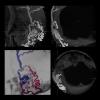This is an example of how virtual reality is being used in neuro-radiology to better evaluate patients using advanced imaging. This dataset shows a patient's brain MRI with fused tractography imaging for pre-operative planning. This was part of a 2018 Radiological Society of North America (RSNA) hands-on session by Vinodh Kumar, M.D., and Komal Shah, M.D., associate professors of radiology at MD Anderson Cancer Center.
Watch the VIDEO: Using Virtual and Augmented Reality to Examine Brain Anatomy and Pathology — an interview with Vinodh Kumar, M.D., and Komal Shah, M.D.
Read the related article Virtual Reality Boosts Revenues and Patient Understanding.








































